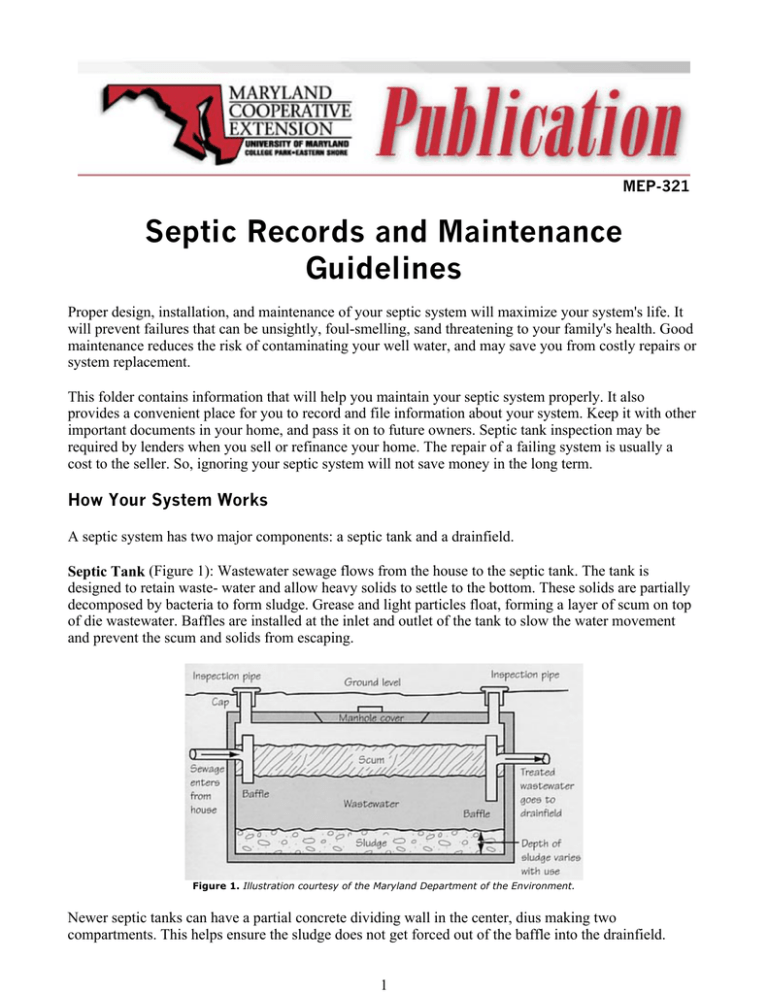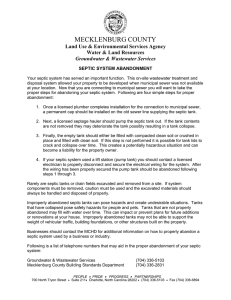Septic Records and Maintenance Guidelines
advertisement

MEP-321 Septic Records and Maintenance Guidelines Proper design, installation, and maintenance of your septic system will maximize your system's life. It will prevent failures that can be unsightly, foul-smelling, sand threatening to your family's health. Good maintenance reduces the risk of contaminating your well water, and may save you from costly repairs or system replacement. This folder contains information that will help you maintain your septic system properly. It also provides a convenient place for you to record and file information about your system. Keep it with other important documents in your home, and pass it on to future owners. Septic tank inspection may be required by lenders when you sell or refinance your home. The repair of a failing system is usually a cost to the seller. So, ignoring your septic system will not save money in the long term. How Your System Works A septic system has two major components: a septic tank and a drainfield. Septic Tank (Figure 1): Wastewater sewage flows from the house to the septic tank. The tank is designed to retain waste- water and allow heavy solids to settle to the bottom. These solids are partially decomposed by bacteria to form sludge. Grease and light particles float, forming a layer of scum on top of die wastewater. Baffles are installed at the inlet and outlet of the tank to slow the water movement and prevent the scum and solids from escaping. Figure 1. Illustration courtesy of the Maryland Department of the Environment. Newer septic tanks can have a partial concrete dividing wall in the center, dius making two compartments. This helps ensure the sludge does not get forced out of the baffle into the drainfield. 1 Newer tanks can also have two manhole covers, one above each baffle. Drainfield (Trench) (Figure 2): A solid pipe leads from the septic tank to a distribution box where the wastewater is channeled into one or more perforated pipes set in trenches of gravel. Here die water slowly infiltrates (seeps) into the underlying soil. Dissolved wastes and bacteria in die water are trapped or adsorbed to soil particles or decomposed by microorganisms that occur naturally in the soil. These processes remove disease-causing organisms, organic matter, and most nutrients (except nitrogen and some salts). The purified wastewater then either moves to the groundwater or evaporates from the soil. Trench systems are the most common type of system used in new home construction. Figure 2. Illustration courtesy of the United States Environmental Protection Agency. An alternative to the common drainfield is the Seepage Pit (Dry Well) (Figure 3). In this type, liquid flows to a pre-cast tank with sidewall holes, surrounded by gravel. (Older versions usually consist of a pit with open-jointed brick or stone walls) Liquid seeps through the holes or joints to the surrounding soil. Figure 3. Illustration courtesy of the United States Environmental Protection Agency. These systems are not widely recommended; however, they may still be used in some cases. Another alternative is the Sand Mound System (Figure 4). These are used when the site is not suitable for traditional septic systems. For instance, the soil may have too much clay to allow the water to seep through at the proper rate, or the water table may be too close to the ground surface. 2 Figure 4. Illustration courtesy of the United States Environmental Protection Agency. In using a sand mound system, the wastewater flows from the septic tank to a storage tank. The liquid is then pumped from the tank to perforated plastic pipes buried in a mound of sand built on the original soil surface. This system provides a layer of suitable soil thick enough to ensure adequate time and distance for proper treatment of the wastewater. Vegetation growing on the mound helps to evaporate some of the liquid. This is particularly important in areas with shallow water tables. Possible Signs of Trouble z z z z The septic tank has not been pumped out in the past five years. Even if the system appears to be working well, sludge may have built up to the point where wastewater is released without sufficient time in the tank for treatment and settling of particles. This situation may result in pollution of groundwater or cause eventual clogging of the drainfield. A wet area or standing water occurs above the drainfield. This situation can develop when sludge particles clog the drainfield, when tree roots or broken pipes keep the wastewater from dispersing through the entire drainfield, or when water use in the house regularly exceeds the design capacity of the system. When these conditions occur, wastewater does not move through the soil as it should, and instead rises to the surface creating a serious health risk and odor problems Toilets run slowly or back up. In the worst cases, the basement is flooded with sewage. This can be the result of plugged sewer lines to the tank, a plugged inlet or outlet pipe, a full septic tank, or a failed drainfield. Septic odors occur in the house, above the tank and drainfield, or escape from the vent pipe. If the system is operating properly, there should be no odors. If there are odors, it can be an early warning sign that the system is failing. 3 Septic System Location Using the box [below] to represent the property, sketch the location of your septic system. Show the location of the septic tank, distribution box, and the lines or seepage pit. Indicate the distance of the septic system from your house and your well. For newer homes, note the area designated for your replacement field (should the original field ever fail). Locating the components of your system can be difficult. Unfortunately, the tank is usually unmarked. Note where your drain pipe leaves the house; this will point you in the direction of the septic tank. Using a small diameter, rigid metal rod as a probe, you can carefully search in this area, and may reveal the septic tank inspection ports and shallow depressions marking the trenches. (In winter months, the tile lines and septic tank are usually the last place frost forms, and the first place snow melts in your yard.) Once you locate an unmarked tank, place a marker in the ground above the inspection ports and the clean-out manhole cover. Or, measure their exact distances from at least two reference points (such as a tree and the corner of the house) so you can easily find them again. If you cannot find any signs of your system, the local Health Department might have your building records on file. 4 Installation Information Installed By: __________________________________________________________ Date Installed: ___________________ Size of Tank: ______________________ []Tiled Field []Deep Trench []Seepage Pit []Sand Mound []Holding Tank Number of Trenches or Pits: ____________________________________________ Maintenance Date Work Performed Company Cost Maintenance Tips Inside Do not add "starter enzymes" or "yeast" to your system. Additives do not improve the performance of your system; there are always plenty of natural bacteria available to do the job. In fact, additives can damage your system by breaking up the sludge and scum layers, causing solids to flush out of the tank and clog the drainfield. z z z z z z Conserve water to extend the life and increase the efficiency of your septic system. Fix leaks and drips. If you replace old fixtures, install new "low flow" types. Do not overload the system- this is the primary cause of system failures. Early morning and bedtime are peak use times in the bathroom. Run dishwashers and washing machines at other times of the day. Don't do all the family laundry in one day. Do not use a garbage disposal or dump coffee grounds in the sink. Increasing the load of solids into the tank decreases the capacity and shortens the interval between pumpings. Do not pour fats and oils down the drain. They can build up and clog the septic tank pipes. Put paper towels, tissue, cigarette butts, disposable diapers, sanitary napkins, tampons, and other material in a trash can, not the toilet. Use normal amounts of detergents, bleaches, drain cleaners, household cleaners, and other products. Avoid dumping solvents like dry deaning fluid, pesticides, photographic chemicals, paint thinner, or auto products down the drain. 5 Outside Tanks generally need to be pumped every 2 to 5 years, depending on use, the size of the tank, and the number of people in the house. If the tank gets too full, particles of scum or sludge will flush out of the tank. This material will clog the drain tiles and cause the septic system to fail. z z z z Hire a licensed professional (listed in the phone book under "septic tank deaners") to pump the waste out of your tank. The tank should be pumped out through the manhole, not the smaller inspection ports. The tank should be emptied completely, leaving nothing in the tank. Do not clean the tank with any chemical. Make sure the baffles are inspected for any damage and that the tank is checked for cracks and leaks. Direct down spouts and runoff away from the septic field to avoid saturating the area with excess water. Dense grass cover and other shallow rooted plants are beneficial over a septic field. However, do not plant trees near a drainfield because large plant roots can clog or break the pipes. Avoid compacting the soil over the drainfield. Do not drive or park vehicles over the area and don't build a shed or driveway in this area. These activities can also crack pipes or cause the distribution box to settle unevenly, meaning that effluent will only flow into part of the drainfield. Many thanks to Dr. William Magette and Dr. Herbert Brodie for their helpful suggestions and information. For additional information on related topics, answers to questions, or comments, please contact: Septic Records and Maintenance Guidelines by Thomas H. Miller Regional Extension Specialist Water Quality and Environmental Programs Maryland Cooperative Extension EO. Box 169, Queensto\vn, MD 21658-0169 410-827-8056 Fax:410-827-9039 Email: tm26@urnail.umd.edu For additional information on water and environmental topics, check out: http://www.agnr.umd.edu/water Issued in furtherance of Cooperative Extension work, acts of May 8 and June 30, 1914, in cooperation with the U.S. Department of Agriculture, University of Maryland, College Park, and local governments, Thomas A. Fretz, Director of Maryland Cooperative Extension, University of Maryland. The University of Maryland is equal opportunity. The University’s policies, programs, and activities are in conformance with pertinent Federal and State laws and regulations on nondiscrimination regarding race, color, religion, age, national origin, gender, sexual orientation, marital or parental status, or disability. Inquiries regarding compliance with Title VI of the Civil Rights Act of 1964, as amended; Title IX of the Education Amendments; Section 504 of the Rehabilitation Act of 1973; and the Americans With Disabilities Act of 1990; or related legal requirements should be directed to the Director of Human Resources Management, Office of the Dean, College of Agriculture and Natural Resources, Symons Hall, College Park, MD 20742. 2002 6




